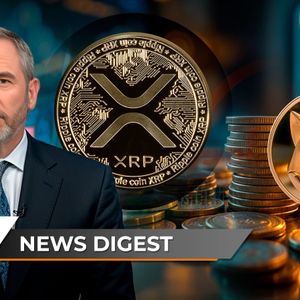Big news from the world of Ethereum Classic! On May 6th, the Ethereum Classic (ETC) DAO officially announced the commencement of the much-anticipated Olympia Upgrade. This isn’t just another minor tweak; it’s a significant leap forward for the Ethereum Classic network, bringing a wave of enhancements designed to boost compatibility, introduce sustainable funding, and empower the community through decentralized governance. What is the Olympia Upgrade and Why Does it Matter for Ethereum Classic? The Olympia Upgrade is a multi-faceted protocol improvement for the ETC blockchain. At its core, the upgrade aims to align Ethereum Classic more closely with the Ethereum Virtual Machine (EVM) ecosystem, making it easier for developers and projects to operate across both chains. However, its impact goes far beyond technical compatibility. Olympia lays down the foundation for the network’s long-term health and decentralization by tackling two critical areas: funding for future development and enabling direct community decision-making. Think of it as ETC getting a major system update that not only patches compatibility issues but also installs brand new modules for funding and democracy. The official announcement from the Ethereum Classic DAO highlighted these key components: Implementation of EIP-1559 Establishment of the Olympia Treasury Launch of the Olympia DAO Let’s dive into each of these components to understand the full scope of the Olympia Upgrade . Decoding EIP-1559: How Does it Change ETC Fees? Perhaps one of the most talked-about features arriving with the Olympia Upgrade is the implementation of Ethereum Improvement Proposal 1559 ( EIP-1559 ). This isn’t a new concept in the blockchain space; it was famously implemented on the Ethereum network in August 2021. Now, Ethereum Classic is adopting a similar model, fundamentally changing how transaction fees work. Before EIP-1559 , ETC used a simple auction-based fee system. Users would bid a gas price, and miners would prioritize transactions with higher bids. This often led to unpredictable fees, especially during periods of high network congestion. With EIP-1559 , the system shifts to a more predictable model involving a ‘base fee’ and an optional ‘priority fee’. Base Fee: This is the minimum fee required for a transaction to be included in the next block. It’s algorithmically determined by the network’s current congestion level, making fees more predictable. Crucially, this base fee is burned , meaning it is removed from circulation forever. Priority Fee (Miner Tip): Users can optionally include a small ‘tip’ to incentivize miners to prioritize their transaction, especially during peak times. This fee goes directly to the miners. Why is burning the base fee significant? For ETC , just as it was for Ethereum, this introduces a deflationary pressure on the supply of Ether Classic. As network usage increases, more ETC is burned, potentially counteracting the issuance of new ETC through mining. This mechanism is seen by many as a positive development for the long-term economic model of the network. Here’s a simplified comparison: Feature Pre-EIP-1559 (Auction) Post-EIP-1559 (Olympia) Fee Calculation User bids gas price (auction) Base fee (algorithmic) + Optional Priority Fee Fee Predictability Low (especially during congestion) Higher (base fee adjusts based on demand) Miner Revenue Receives total transaction fee Receives Priority Fee only Supply Impact Neutral (fees go to miners) Deflationary (base fee is burned) Implementing EIP-1559 is a major technical undertaking and signifies ETC’s commitment to adopting proven mechanisms from the wider EVM ecosystem while introducing a potentially powerful economic dynamic for its native asset. Funding the Future: The Olympia Treasury Another cornerstone of the Olympia Upgrade is the establishment of the Olympia Treasury. Funding decentralized protocol development and maintenance has historically been a challenge for many blockchain networks. Relying solely on volunteer efforts or external grants can be inconsistent and unsustainable. The Olympia Treasury is designed to address this by creating a dedicated, on-chain funding mechanism. While the specifics of how the Treasury is funded (e.g., a portion of block rewards, transaction fees, etc.) were not detailed in the initial brief announcement, the concept is clear: create a pool of funds controlled by the community to support projects that benefit the Ethereum Classic ecosystem. Imagine a shared community chest specifically for funding improvements, research, tooling, or ecosystem growth initiatives. This treasury provides a stable and transparent source of funding, reducing reliance on potentially centralized entities or sporadic donations. It aligns incentives, ensuring that the community itself can direct resources towards what it deems most important for the network’s evolution. Empowering the Community: The Olympia DAO Complementing the Olympia Treasury is the launch of the Olympia DAO (Decentralized Autonomous Organization). This is where the ‘governance’ aspect of the upgrade truly shines. The Ethereum Classic DAO emphasized that the Olympia DAO is the platform enabling community members to actively participate in the network’s direction. What does participation mean in this context? It means having a voice and a vote on how the network evolves and how the funds in the Olympia Treasury are utilized. The Olympia DAO is intended to provide a structured framework for: Proposal Submission: Community members can submit formal proposals for protocol changes, funding requests from the Treasury, ecosystem initiatives, and more. Discussion and Deliberation: Proposals are open for discussion and debate among the community, allowing for thorough review and feedback. On-Chain Voting: Eligible community members (likely based on ETC holdings or other defined criteria) can cast votes on submitted proposals directly on the blockchain. This ensures transparency and immutability in the decision-making process. This move towards a formal, on-chain DAO structure is a significant step for Ethereum Classic . It decentralizes power further, moving away from reliance on core developer teams or informal consensus mechanisms towards a system where the token holders themselves have direct influence. This aligns with the core ethos of blockchain technology – decentralization and censorship resistance. Benefits and Potential Challenges of the Olympia Upgrade The Olympia Upgrade brings a host of potential benefits to the ETC network and its community: Improved EVM Compatibility: Makes it easier for developers to port dApps from Ethereum or build new ones on ETC, potentially increasing network activity. More Predictable Fees: EIP-1559 helps users estimate transaction costs more accurately, improving the user experience. Deflationary Pressure: The fee burning mechanism introduces a new economic dynamic that could positively impact the value proposition of ETC over time. Sustainable Funding: The Olympia Treasury provides a dedicated source for ecosystem development, fostering innovation and growth. Decentralized Governance: The Olympia DAO empowers the community, making the network more resilient and aligned with the interests of its stakeholders. Enhanced Transparency: On-chain governance processes are inherently transparent and auditable. However, like any major network upgrade, there are potential challenges or considerations: Implementation Complexity: Integrating EIP-1559 and building the DAO infrastructure is a complex technical task. Community Engagement: The success of the DAO depends heavily on active and informed participation from the community. Voter apathy could hinder the governance process. Treasury Management: Deciding how to allocate Treasury funds effectively and transparently will be crucial. Potential for Centralization (Paradoxically): While DAOs aim for decentralization, large token holders can sometimes exert disproportionate influence. Designing fair voting mechanisms is key. The success of Olympia will ultimately depend on the smooth technical implementation and the active, constructive engagement of the Ethereum Classic community within the new governance framework. What Does This Mean for ETC Holders and Developers? For existing ETC holders, the Olympia Upgrade signifies a commitment to modernizing the network, enhancing its economic model through EIP-1559 ‘s burning mechanism, and providing a direct pathway for influencing the network’s future via the Olympia DAO . It’s an opportunity to become more involved than ever before. For developers looking to build on Ethereum Classic , the improved EVM compatibility makes the platform more attractive. The potential for funding through the Olympia Treasury could also incentivize new projects to choose ETC. Actionable insights: Stay Informed: Follow the official ETC DAO channels and community forums for updates on proposals and voting. Get Involved: Participate in discussions and consider submitting or voting on proposals within the Olympia DAO . Understand the Changes: Familiarize yourself with how EIP-1559 affects transaction fees. Looking Ahead: The Future Shaped by the Olympia Upgrade The commencement of the Olympia Upgrade marks a pivotal moment for Ethereum Classic . By integrating EIP-1559 , establishing the Olympia Treasury, and launching the Olympia DAO , the network is taking decisive steps towards greater technical alignment with the EVM ecosystem, economic sustainability, and truly decentralized governance. This upgrade is not an endpoint but rather a new beginning, empowering the community to collectively steer the future development and growth of the ETC blockchain. The coming months will be critical as the community begins to utilize the new governance tools and the effects of EIP-1559 become more apparent. The success of the Olympia Upgrade hinges on robust community participation and the effective management of the new decentralized structures. To learn more about the latest Ethereum Classic trends, explore our article on key developments shaping ETC ecosystem growth .


















